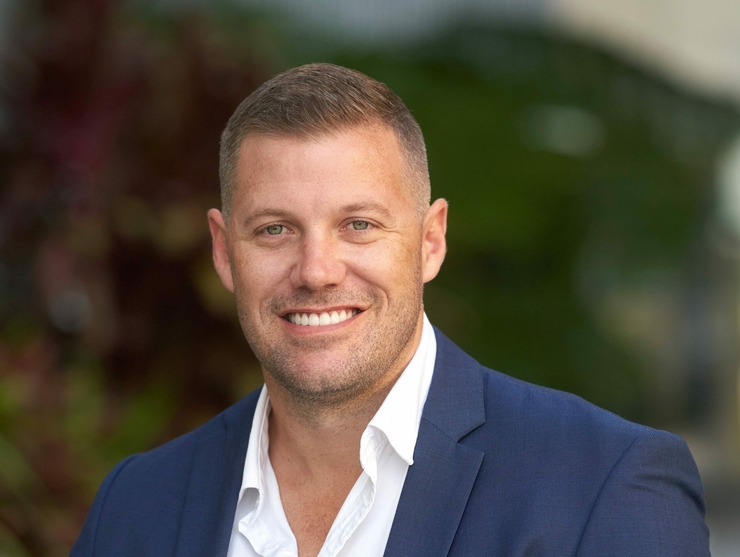For Dr Anthony Murray, there's only one way to do things – go big or go home.
Standing at six foot 10 inches, the former AFL player is Australia's first Indigenous orthopaedic surgeon, and his patients would say his heart matches his stature.
"To be a trailblazer in anything, you've got to go big," Dr Murray said.
"You've got to be prepared to shoulder a lot more responsibility and be on boards and all that kind of thing.
"And you know, from the outside sometimes that might look like tokenism, but from the inside it's a great opportunity and a great responsibility. You have to be prepared to go as big as you can."
It was the football pitch, not the operating theatre, where Dr Murray first set his sights as a younger man.
"I was playing AFL in Hervey Bay, I was trying to make it big, and I took a mark, and it blew out my knee," he said.
"I've had a lot of surgeries on the knee since then! At the time, my brother was a junior doctor in Newcastle, and I spent a lot of time there and I just thought this is what I wanted to do."
Dr Murray said his injury was a blessing in disguise.
"First of all, I wasn't actually very good," he said, laughing.
"My aspirations got mixed up with my abilities.
"Last week I did quite a complex hip surgery on a former St Kilda player and at the end of it his wife was in tears, hugging me ... to be able to help people like that is amazing.
"So, I think I'll just fix the players and the former players. In the long term, it's been a much better option."
Dr Murray trained at Newcastle's John Hunter Hospital where he worked under Australia's first Indigenous surgeon, Kelvin Kong.
"He was there for me, he was the pillar I leant on, and I hope to be able to do the same – not just for Indigenous surgeons, but also GPs, nurses, you name it," he said.
"I hope I can pave the way for others."
For Dr Murray, who also owns a farm, practising medicine in a regional area was a no-brainer and he now operates at Bundaberg's Friendly Society Private Hospital.
"I grew up in regional areas – Rocky, Hervey Bay, Bundaberg, and as a consequence I was always going to return," he said.
"I love the lifestyle. I want the most amount of traffic I deal with to be two cars on the roundabout.
"I like to go home to family and my farm and switch off. I get on the tractor or I deal with my animals, and it's a form of mindfulness for me. And that's really important.
"When I was a kid, to do the shopping you had to go to Brisbane, but that's no longer the case. These regional centres are major hubs and for people to be able to get care – and a proper high level of care – in their own hometown is great.
"We know people recover better closer to home, their stay in hospital is shorter. And if I practise here, other surgeons will go, 'Oh, I can practise there too' or 'I can come up once a month or once a fortnight for clinics'."
He said working at the hospital, also known as "Friendlies", was a fantastic experience.
"Friendlies has provided a great opportunity for me, it's a great hospital," Dr Murray said.
"They draw talented staff, nursing staff, everyone, allied health. The hospital management is excellent, and I'm very impressed with the theatres and the theatre staff.
"On the wards, all my patients have been telling me how great it is, they feel well looked after – and that's what you want.
"You don't want your blood pressure taken in the morning and then ignored for the rest of the day. That aftercare is so important."
Sandy Blake, Friendly Society Private Hospital's Director of Clinical Services and Patient Safety, welcomed Dr Murray to the surgical team.
"It's really great to have such an experienced senior orthopaedic surgeon come on board who can service our patients and meet people's acute needs through consultations and emergency admissions," she said.
Dr Murray is keen to stay on the cutting edge of surgical technology and is currently using "augmented reality" in his surgeries.
"It's like a heads-up display on the windscreen of your car," he said.
"And when it comes to cutting something so many millimetres, or at a certain angle, it tells you exactly where to go."
Dr Murray also uses 3D printing to make surgical devices and instruments tailored to the patient's anatomy.
"It's making perfectionism even more exceptional," he said.
"We're at the absolute cutting edge of this technology, we're right at the spear tip.
"And it's the sort of thing you would expect to see in New York or London, but people can have this kind of work done here in regional Queensland.
"It will be cool to see what the generation after me has to work with. We're getting amazing results."
Dr Murray said the best advice he could offer for young up and coming doctors was simply "do your best, always".
"If you're going to be first, go big," he said.
"Indigenous people are capable, we are resilient, we can do amazing things. We can lead and be the best in so many areas and you just have to put your mind to it.
"I've got humongous feet and I hope there will be people coming after me to fill those boots."
Read more: $3m investment to keep saving lives
Read more: New program to develop Indigenous nurses
Next On The Ground:
11/7/2023 NAIDOC Week: Artist donates 'Healing Hands'
Previous On The Ground:
14/6/2023 Unexpected reunion for chess mates
![[APHA]](/images/logo_apha.svg)
